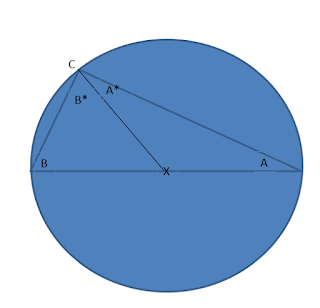The original
theorem, as stated by the Greek mathematician Thales, is all triangles inscribed
in a circle with two corners diametrically opposed are right triangles. Note:
right triangles are triangles with one angle that is 90 degrees (a right
angle).
Lesson
First look at some
of the example triangles inscribed in the circles below. They all appear to be
right triangles.
Proof
Although all the
examples drawn above have right angles (the angles with yellow square), that
doesn’t prove that all such inscribed
triangles should be right triangles.
The proof of
Thales uses three known facts that were previously established by early mathematicians.
Fact 1 is that all points on a circle are the same distance from the center of
the circle (this is actually the definition of a circle). Fact 2 is that any
triangle with two equal sides (an isosceles triangle) also has two equal
angles. Fact 3 is that the sum of the interior angles of a triangle equals 180
degrees (this is also another lesson in this book). Let’s draw an inscribed
triangle within the circle and we’ll label the angles of the triangle as A, B,
C.
For the next step
of the proof, we’ll add a new point, X, on the diameter at the center of the
circle. Draw a line from X to the corner at angle C (shown above). Also, the angle C is now split into two angles
which are labelled A* and B*.
We’ll use the
three given facts from above. Using Fact 1, the length of line XC equals the
length of line XA. Using Fact 2, the triangle AXC has two sides of equal length
therefore the angle A* is the same as the angle A.
Repeating these
steps for the BXC; using Fact 1 the lengths of lines XB and XC are the same.
Using Fact 2, angle B* is the same as angle B.
Finally using Fact
3, the angles A + B + C = 180 degrees. Angle C equals A* + B* which is the same
as A+B. Substituting C for A+B in Fact 3
gives us C + C = 180 degrees or 2C= 180 degrees. Therefore angle C = 180/2 = 90
degrees (or angle C is a right angle).
Alternate Application
The theorem can
also be used in reverse to locate the center of any circle. Start with any
circle and place a sheet of rectangular paper (any size will do) so a corner is
touching the circle (see point A). Mark the points where the two sides coming
off that corner intersect the circle (see points B and C). Draw a line between
points B and C – these points are now diametrically opposed.
Update 8/23/2021:
Some believe Thales should be given credit for first visualizing a proof to the Pythagorean Theorem: See: Should we rename the Pythagorean theorem? - Big Think.







No comments:
Post a Comment